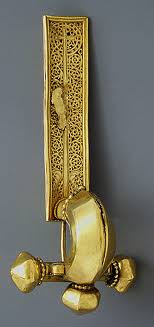A Late Antique Crossbow Fibula in the Metropolitan Museum of Art
Deppert-Lippitz, Barbara
Metropolitan Museum Journal, Vol. 35 (2000)
Abstract
In 1995 The Metropolitan Museum of Art acquired a gold brooch of a type generally known as the crossbow fibula (Figures 1, 2).’ At 11.9 centimeters in length (about 411/16 in.), with a weight of 78.4 grams, it is a personal ornament of substantial size and value and of the highest technical and artistic quality. The object stands out both in art history and in a larger historical perspective.Dating to the late fifth or early sixth century, it evokes one of the most interesting epochs in antiquity, a period marked by the subtle, often elusive transition from Late Roman to Early Byzantine art. The strong religious elements in the decoration of this fibula, and of related pieces, allow us a glimpse into the iconographic language of Early Christian art. Perhaps even more fascinating than the art-historical, religious, and technical aspects, howev- er, are the historical implications. Crossbow fibulae were first introduced about A.D. 200 as clasps for military cloaks but immediately became an official insignia of military and administrative rank.
A Late Antique Crossbow Fibula in the Metropolitan Museum of Art
Deppert-Lippitz, Barbara
Metropolitan Museum Journal, Vol. 35 (2000)
Abstract
In 1995 The Metropolitan Museum of Art acquired a gold brooch of a type generally known as the crossbow fibula (Figures 1, 2).’ At 11.9 centimeters in length (about 411/16 in.), with a weight of 78.4 grams, it is a personal ornament of substantial size and value and of the highest technical and artistic quality. The object stands out both in art history and in a larger historical perspective.Dating to the late fifth or early sixth century, it evokes one of the most interesting epochs in antiquity, a period marked by the subtle, often elusive transition from Late Roman to Early Byzantine art. The strong religious elements in the decoration of this fibula, and of related pieces, allow us a glimpse into the iconographic language of Early Christian art. Perhaps even more fascinating than the art-historical, religious, and technical aspects, howev- er, are the historical implications. Crossbow fibulae were first introduced about A.D. 200 as clasps for military cloaks but immediately became an official insignia of military and administrative rank.
period marked by the subtle, often elusive transition from Late Roman to Early Byzantine art. The strong religious elements in the decoration of this fibula, and of related pieces, allow us a glimpse into the iconographic language of Early Christian art. Perhaps even more fascinating than the art-historical, religious, and technical aspects, howev- er, are the historical implications. Crossbow fibulae were first introduced about A.D. 200 as clasps for military cloaks but immediately became an official insignia of military and administrative rank.
Click here to read this article from the Metropolitan Museum Journal
Subscribe to Medievalverse
Related Posts